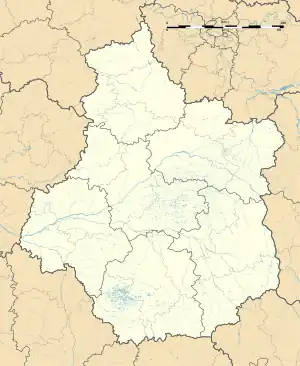Rouvray-Saint-Denis | |
|---|---|
 The church of Saint Denis | |
Location of Rouvray-Saint-Denis | |
 Rouvray-Saint-Denis  Rouvray-Saint-Denis | |
| Coordinates: 48°16′44″N 1°56′43″E / 48.2789°N 1.9453°E | |
| Country | France |
| Region | Centre-Val de Loire |
| Department | Eure-et-Loir |
| Arrondissement | Chartres |
| Canton | Les Villages Vovéens |
| Government | |
| • Mayor (2020–2026) | Pascal Reau[1] |
| Area 1 | 19.35 km2 (7.47 sq mi) |
| Population | 341 |
| • Density | 18/km2 (46/sq mi) |
| Time zone | UTC+01:00 (CET) |
| • Summer (DST) | UTC+02:00 (CEST) |
| INSEE/Postal code | 28319 /28310 |
| Elevation | 129–147 m (423–482 ft) (avg. 138 m or 453 ft) |
| 1 French Land Register data, which excludes lakes, ponds, glaciers > 1 km2 (0.386 sq mi or 247 acres) and river estuaries. | |
Rouvray-Saint-Denis (French pronunciation: [ʁuvʁɛ sɛ̃ dəni]) is a commune in the Eure-et-Loir department in northern France.
History
It has long been thought that it was the site of the Battle of the Herrings in 1429, when Sir John Fastolf beat off an attack on an English convoy taking supplies to the siege of Orléans; but in his biography of Fastolf, The Real Falstaff, Stephen Cooper argues that the battle is more likely to have taken place at Rouvray-Sainte-Croix.
Population
| Year | Pop. | ±% |
|---|---|---|
| 1962 | 385 | — |
| 1968 | 358 | −7.0% |
| 1975 | 308 | −14.0% |
| 1982 | 309 | +0.3% |
| 1990 | 326 | +5.5% |
| 1999 | 359 | +10.1% |
| 2008 | 435 | +21.2% |
See also
References
- ↑ "Répertoire national des élus: les maires" (in French). data.gouv.fr, Plateforme ouverte des données publiques françaises. 4 May 2022.
- ↑ "Populations légales 2021". The National Institute of Statistics and Economic Studies. 28 December 2023.
Wikimedia Commons has media related to Rouvray-Saint-Denis.
This article is issued from Wikipedia. The text is licensed under Creative Commons - Attribution - Sharealike. Additional terms may apply for the media files.